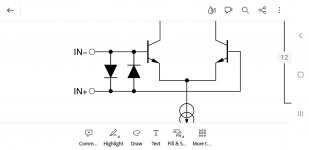Hello, guys.
I have diyinhk es9038pro board and try muses8920 for i/v and LPF.
Sound is very good, especialy a voice but sometimes I hear a little distortions.
Now I use OPA1612 for i/v and LPF, distortion is gone but sound is flat.
Also they are very hot.
9038 recomendation is OPA1612, OPA1656, OPA1688 and OPA1622
Maybe someone can give a advice.
I have diyinhk es9038pro board and try muses8920 for i/v and LPF.
Sound is very good, especialy a voice but sometimes I hear a little distortions.
Now I use OPA1612 for i/v and LPF, distortion is gone but sound is flat.
Also they are very hot.
9038 recomendation is OPA1612, OPA1656, OPA1688 and OPA1622
Maybe someone can give a advice.
1612 uses 4-5mA max IqHello, guys.
I have diyinhk es9038pro board and try muses8920 for i/v and LPF.
Sound is very good, especialy a voice but sometimes I hear a little distortions.
Now I use OPA1612 for i/v and LPF, distortion is gone but sound is flat.
Also they are very hot.
9038 recomendation is OPA1612, OPA1656, OPA1688 and OPA1622
Maybe someone can give a advice.
Based on what I highlighted above, you may have oscillations issues... 1612 should not get very hot.
ES9038PRO chips run hot so anything in the vicinity of those chips will be warm as well. Thermal image would reveal which parts are actually running hot.
opa1656 but not one, use more opa1656 in parallel. The current will be divided equally between the op-amps. The opamps will work more easily and you will have a stronger output. Of course the resistors will be increased so that you get the same output voltage. The filter capacitors will be reduced so as to keep the same cutoff frequency. Ordinary opamps are no longer suitable alone for the new chips with very strong output current. They must be used either in parallel or with a buffer on the output.
Of course, you can use opa2156 or lm6172 in parallel.
Of course, you can use opa2156 or lm6172 in parallel.
IME if OPA1612 doesn't sound good then something else is wrong somewhere. If it sounds flat could be a problem with its bypass caps, their layout, etc. They just don't normally run hot. How hot are you talking about anyway? Uncomfortable to hold you finger on one? Might help to look with a scope too. Do you have one I/V opamp per dac output or something else? Do all the I/V opamps get equally hot?
Do you have a schematic for that part of the circuit?
Also, is there an IC in a socket, or an IC mounted on a dip adapter, on the other side of the board?
How close are the I/V opamps to the dac chip? Are they on the same side of the board?
Also, is there an IC in a socket, or an IC mounted on a dip adapter, on the other side of the board?
How close are the I/V opamps to the dac chip? Are they on the same side of the board?
MUSES 8920 was a fake, opa1656 in I/V and opa1622 on LPF sound ok.
maybe need to try opa1622 on I/V.

maybe need to try opa1622 on I/V.
If you have OPA1622 on a DIP adapter, it will have more distortion that it is supposed to. It has a pin that is supposed to be connected to ground. That's why it has 10 pins instead of only 8.
- Home
- Source & Line
- Digital Source
- ES9038PRO best I/V op amp
